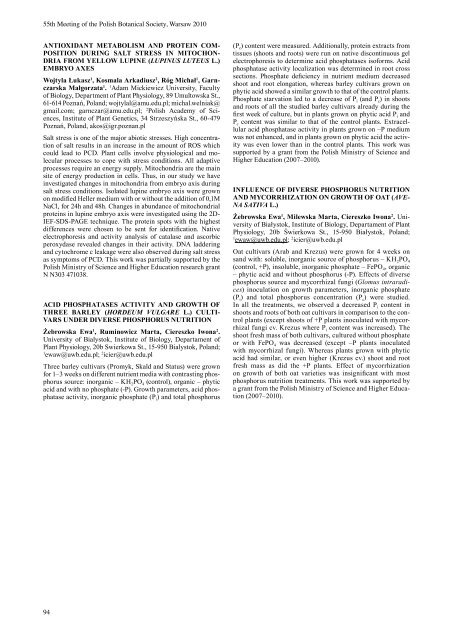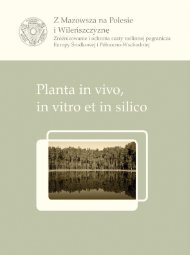acta societatis botanicorum poloniae - LV Zjazd Polskiego ...
acta societatis botanicorum poloniae - LV Zjazd Polskiego ...
acta societatis botanicorum poloniae - LV Zjazd Polskiego ...
You also want an ePaper? Increase the reach of your titles
YUMPU automatically turns print PDFs into web optimized ePapers that Google loves.
55th Meeting of the Polish Botanical Society, Warsaw 2010<br />
ANTIOxIdANT METABOLISM ANd PrOTEIN COM-<br />
POSITION dUrING SALT STrESS IN MITOCHONdrIA<br />
FrOM YELLOW LUPINE (luPinus luteus L.)<br />
EMBrYO AxES<br />
Wojtyla Łukasz 1 , Kosmala Arkadiusz 2 , Róg Michał 1 , Garnczarska<br />
Małgorzata 1 . 1 Adam Mickiewicz University, Faculty<br />
of Biology, Department of Plant Physiology, 89 Umultowska St.,<br />
61-614 Poznań, Poland; wojtylal@amu.edu.pl; michal.welniak@<br />
gmail.com; garnczar@amu.edu.pl; 2 Polish Academy of Sciences,<br />
Institute of Plant Genetics, 34 Strzeszyńska St., 60-479<br />
Poznań, Poland, akos@igr.poznan.pl<br />
Salt stress is one of the major abiotic stresses. High concentration<br />
of salt results in an increase in the amount of ROS which<br />
could lead to PCD. Plant cells involve physiological and molecular<br />
processes to cope with stress conditions. All adaptive<br />
processes require an energy supply. Mitochondria are the main<br />
site of energy production in cells. Thus, in our study we have<br />
investigated changes in mitochondria from embryo axis during<br />
salt stress conditions. Isolated lupine embryo axis were grown<br />
on modified Heller medium with or without the addition of 0,1M<br />
NaCl, for 24h and 48h. Changes in abundance of mitochondrial<br />
proteins in lupine embryo axis were investigated using the 2D-<br />
IEF-SDS-PAGE technique. The protein spots with the highest<br />
differences were chosen to be sent for identification. Native<br />
electrophoresis and activity analysis of catalase and ascorbic<br />
peroxydase revealed changes in their activity. DNA laddering<br />
and cytochrome c leakage were also observed during salt stress<br />
as symptoms of PCD. This work was partially supported by the<br />
Polish Ministry of Science and Higher Education research grant<br />
N N303 471038.<br />
ACId PHOSPHATASES ACTIVITY ANd GrOWTH OF<br />
THrEE BArLEY (hordeum vulGAre L.) CULTI-<br />
VArS UNdEr dIVErSE PHOSPHOrUS NUTrITION<br />
żebrowska Ewa 1 , ruminowicz Marta, Ciereszko Iwona 2 .<br />
University of Bialystok, Institute of Biology, Departament of<br />
Plant Physiology, 20b Swierkowa St., 15-950 Bialystok, Poland;<br />
1 ewaw@uwb.edu.pl; 2 icier@uwb.edu.pl<br />
Three barley cultivars (Promyk, Skald and Status) were grown<br />
for 1– 3 weeks on different nutrient media with contrasting phosphorus<br />
source: inorganic – KH 2PO 4 (control), organic – phytic<br />
acid and with no phosphate (-P). Growth parameters, acid phosphatase<br />
activity, inorganic phosphate (P i) and total phosphorus<br />
94<br />
(P c) content were measured. Additionally, protein extracts from<br />
tissues (shoots and roots) were run on native discontinuous gel<br />
electrophoresis to determine acid phosphatases isoforms. Acid<br />
phosphatase activity localization was determined in root cross<br />
sections. Phosphate deficiency in nutrient medium decreased<br />
shoot and root elongation, whereas barley cultivars grown on<br />
phytic acid showed a similar growth to that of the control plants.<br />
Phosphate starvation led to a decrease of P i (and P c) in shoots<br />
and roots of all the studied barley cultivars already during the<br />
first week of culture, but in plants grown on phytic acid P i and<br />
P c content was similar to that of the control plants. Extracellular<br />
acid phosphatase activity in plants grown on –P medium<br />
was not enhanced, and in plants grown on phytic acid the activity<br />
was even lower than in the control plants. This work was<br />
supported by a grant from the Polish Ministry of Science and<br />
Higher Education (2007– 2010).<br />
INFLUENCE OF dIVErSE PHOSPHOrUS NUTrITION<br />
ANd MYCOrrHIZATION ON GrOWTH OF OAT (AvenA<br />
sAtivA L.)<br />
żebrowska Ewa 1 , Milewska Marta, Ciereszko Iwona 2 . University<br />
of Białystok, Institute of Biology, Departament of Plant<br />
Physiology, 20b Świerkowa St., 15-950 Białystok, Poland;<br />
1 ewaw@uwb.edu.pl; 2 icier@uwb.edu.pl<br />
Oat cultivars (Arab and Krezus) were grown for 4 weeks on<br />
sand with: soluble, inorganic source of phosphorus – KH 2PO 4<br />
(control, +P), insoluble, inorganic phosphate – FePO 4, organic<br />
– phytic acid and without phosphorus (-P). Effects of diverse<br />
phosphorus source and mycorrhizal fungi (Glomus intraradices)<br />
inoculation on growth parameters, inorganic phosphate<br />
(P i) and total phosphorus concentration (P c) were studied.<br />
In all the treatments, we observed a decreased P i content in<br />
shoots and roots of both oat cultivars in comparison to the control<br />
plants (except shoots of +P plants inoculated with mycorrhizal<br />
fungi cv. Krezus where P i content was increased). The<br />
shoot fresh mass of both cultivars, cultured without phosphate<br />
or with FePO 4 was decreased (except –P plants inoculated<br />
with mycorrhizal fungi). Whereas plants grown with phytic<br />
acid had similar, or even higher (Krezus cv.) shoot and root<br />
fresh mass as did the +P plants. Effect of mycorrhization<br />
on growth of both oat varieties was insignificant with most<br />
phosphorus nutrition treatments. This work was supported by<br />
a grant from the Polish Ministry of Science and Higher Education<br />
(2007– 2010).



